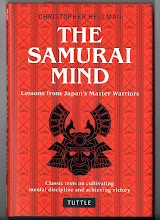My first encounter with nanten gave me a rather different impression - I had come across it years before I came to Japan in the book Zen and the Art of Calligraphy by Omori Sogen and Terayama Tanchu, now out of print but worth getting hold of if you’re interested in that kind of thing, in the form of the staff wielded by the Zen teacher who took his name from it – Nakahara Nantenbo (1839-1925). It's hard to believe, but information about that kind of thing was hard to get hold of in those days. The mental image of a fierce Zen practitioner and his nanten staff stayed with me, but it was only quite recently that I came across a picture of him and what might be his staff. I had imagined it would be something like the one in the picture below, but in fact that might not be the case.
 |
| An earlyish picture of the famous priest with quite a fearsome looking staff. |
He was known for his unstinting efforts to preserve and revitalize the Rinzai Zen tradition but is perhaps better known in the west for his calligraphy and Zen paintings. Like Yamaoka Tesshu, the swordsman, calligrapher and statesman, he produced huge numbers of works, although unlike Tesshu, he professed no skill in the art. He was similar to Tesshu, too, in the ferocity which he brought to his practice, regularly engaging in Dharma combat with other priests reportedly chasing the losers out of their temples. He and Tesshu had something of a rivalry, and though Tesshu may have practised under him, they were also reported to have taken part in Dharma battles with each other, with neither giving an inch.
 |
| A picture by Tesshu of Nantenbo teaching his charges. (From Stevens' The Sword of No Sword') |
As Tesshu's picture (and Deishu's verse) suggest, Nantenbo was also famous for his liberal use of his staff as a part of his teaching and it was this staff, cut from a 200 year old nanten bush he came across in his travels, that earned him his sobriquet. It was also the subject of his most distinctive paintings. The photograph below may show the staff.
 |
| An older looking Nantenbo, but is that his staff? |
 |
| In this painting of his staff, the resemblance to the photograph is clear |
However, his paintings are often titled ‘shakujo’ (although it is unlikely he gave them titles himself), which is a priest’s walking staff. The photograph near the top of the page looks more like a walking staff, and you would certainly remember if you'd been hit with it. Later in his career, he retired his famous staff, apparently giving it into the keeping of Empuku-ji, where it probably remains to this day…or so I thought, before finding a reference to it in a couple of catalogues from the late eighties from the museum of Zuigan-ji, where Nantenbo was, at one time, abbot. This is also the temple that was founded by the famous warrior Date Masamune, (see here for more information), and from which Nantenbo retired his abbotship after the famous statue of the warlord was damaged by an acolyte. It was also after this incident and a subsequent period of self-reflection that he retired his nanten stick from service, so the connection with Zuigan-ji seems more likely. It does suggest a problem with the photograph – he apparently retired the staff around 1893, when he was in his early fifties, but he looks much older in the lower picture. Perhaps that is not his nanten staff after all.
Coming from a samurai family and having a strong, somewhat unruly nature, it might not be surprising that he kept company with martial artists and members of the military (including the famous generals Nogi Maresuke and Kodama Gentaro, both of whom were students of his). One of his notable students, Deiryu, was introduced by his brother’s kendo teacher, and in the early 1870s, Nantenbo was actually in command of a local militia (albeit one consisting of clergy, doctors and Confucian scholars), apparently training them in the use of the sword, spear and bow. Although not overly tall, he was powerfully built and also unusually strong. It was reported that he had travelled through the country during the 2nd Choshu Expedition (1865) and had shown he could take care of himself on several occasions.
He also had at least one ardent kendo practitioners amongst his students. A certain Yoshida Masahiro related the story of studying under him to improve his kendo. After a few months during which he made no headway with his study, Nantenbo told him he should give up kendo (meaning that he would get nowhere if he couldn’t figure this out). Nantenbo had apparently set him a kind of koan by striking a small bell and (presumeably, although the account I read was not clear, asking him something like "Does the sound come from the strike or the bell?). Yoshida spent a further 3 years before he had a sudden realisation while getting on a bus, that there was no separation between the strike and the sound, and thus in kendo there was no separation between the striker and his opponent. For Yoshida, those 3 years were very tough, but he makes no mention of the methods that Nantenbo used, except that he struck the bell 6 times. It must be noted that for a kendo student, especially in those days, being struck in training would not have been anything to note. This may have been in Nantenbo's later, 'gentler' days.
So much for Nantenbo's staff. I would like to track down a picture of it – if I'm successful, I will post it here.











